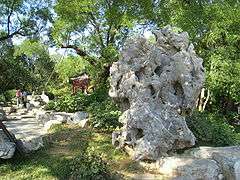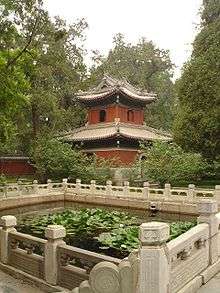Beijing Botanical Garden
The Beijing Botanical Garden (Chinese: 北京植物园; pinyin: Běijīng Zhíwùyuán) is a botanical garden situated in the northwestern outskirts of Beijing, China between Xiangshan (Fragrant Hills) Park and Jade Spring Mountain (zh:玉泉山) in the Western Hills.[1]
| Beijing Botanical Garden | |
|---|---|
 | |
 Beijing Botanical Garden  Beijing Botanical Garden | |
| Type | Urban park |
| Location | Beijing, China |
| Coordinates | 39°59′34″N 116°12′34″E |
| Area | 400 hectares |
| Created | 1956 |
| Owned by | Beijing Municipal Administration Center of Parks |
| Status | Open all year |
History
The Beijing Botanical Garden was established in 1955. It covers a large area of 564,000 square metres. The gardens include a dozen exhibition districts and halls, such as the tree garden, a perennial bulb garden, a rose garden, a peony garden, a traditional Chinese medical herb garden, a wild fruit resources district, an environment protection plant district, a water and vine plant district, an endangered plant district, and exhibition greenhouses for tropical and subtropical plants. There are several Buddhist temples located within the botanic gardens.
Collection
The gardens cultivate 6,000 species of plant, including 2,000 kinds of trees and bushes, 1,620 varieties of tropical and subtropical plants, 500 species of flowers and 1,900 kinds of fruit trees, water plants, traditional Chinese.
The hothouse exhibition is the highlight of the gardens.
- The first room is filled with evergreens and members of the palm family.
- The second room is given over to tropical aquatic plants, including water lilies and flowering taros.
- The third room displays commercial plants and their breeding and propagation. Here there are specimens of the triple-leaved rubber plant, cocoa and coffee trees and the sugar producing sweet-leaved chrysanthemum which has been introduced into China from abroad.
There are rooms for demonstrating medicinal plants, aromatic plants and succulents. The exhibition of ornamental plants is spectacular with its countless varieties if flowers and grasses. There are over 300 different varieties of orchid, among them a rootless one that relies on fine hairs to absorb water vapor and nutrients from the air.

Besides the hothouse, there is also a national plant specimen hall with a floor space of 11,000 square meters. Specimen houses, plant classification laboratories, research rooms and a lecture hall are arranged around a courtyard linked by arches and trellises.


The Peony Garden was open to the public in 1981. It covers an area of 100,000 square meters and is divided into three sections. The Peony Grove is the most important, covering an area of 35,000 square meters.
The plant collection includes many rare species. There is, for example, the metasequoia first discovered in the region of Hubei and Sichuan by a Chinese scientist in the 1940s. Since it was originally believed that it had become extinct during the Paleogene Period (66 million years ago), the discovery of living specimens in China came as a tremendous surprise to botanists.
Other plants in the gardens include Nepenthes pitcher plants, which are carnivorous plants; the golden butterfly orchid with its lustrous yellow flowers; the American redwood; the Japanese blossoming cherry, and the famous "bodi tree", the tree under which Buddha sat when he gained enlightenment.
Gallery and display of flowers



.jpg)




- Memorial to the December 9th Movement of 1935.
See also
References
- "Beijing Botanical Garden". Archived from the original on 2011-06-23. Retrieved 2010-12-22.
External links
| Wikimedia Commons has media related to Beijing Botanical Garden. |